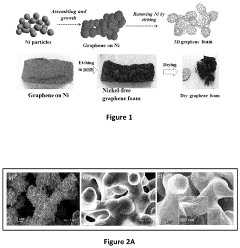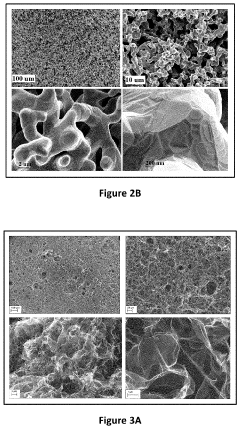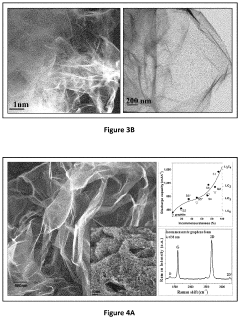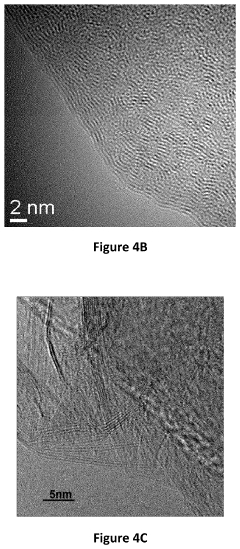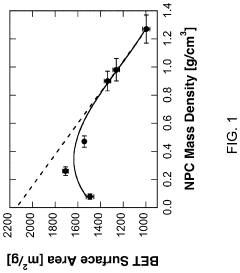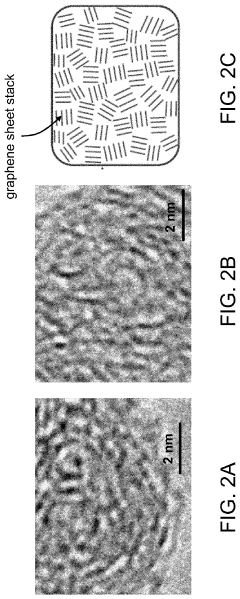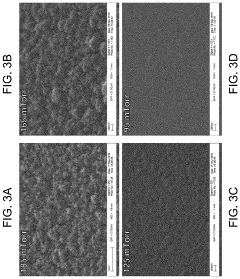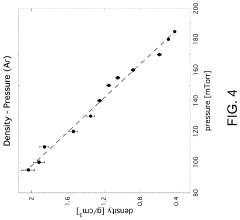Graphene Battery's Role in Future Energy Networks
AUG 6, 20259 MIN READ
Generate Your Research Report Instantly with AI Agent
Patsnap Eureka helps you evaluate technical feasibility & market potential.
Graphene Battery Evolution and Objectives
Graphene batteries represent a revolutionary advancement in energy storage technology, poised to transform future energy networks. The evolution of graphene batteries can be traced back to the discovery of graphene in 2004, which sparked intense research into its potential applications. Since then, the development of graphene-based energy storage solutions has progressed rapidly, driven by the need for more efficient and sustainable power sources.
The primary objective of graphene battery technology is to overcome the limitations of traditional lithium-ion batteries, such as limited energy density, slow charging times, and degradation over multiple charge cycles. Graphene's unique properties, including high electrical conductivity, mechanical strength, and large surface area, make it an ideal material for enhancing battery performance.
In the context of future energy networks, graphene batteries aim to address several key challenges. These include improving grid stability by providing rapid response times for energy storage and release, enabling more efficient integration of renewable energy sources, and supporting the growing demand for electric vehicles with faster charging capabilities and longer ranges.
The evolution of graphene batteries has seen significant milestones in recent years. Researchers have made progress in developing graphene-enhanced electrodes, which have demonstrated improved energy density and faster charging rates compared to conventional batteries. Additionally, graphene-based supercapacitors have shown promise in combining the high power density of capacitors with the energy storage capacity of batteries.
Looking ahead, the objectives for graphene battery technology are ambitious and multifaceted. Scientists and engineers are working towards creating batteries with even higher energy densities, potentially surpassing 1,000 Wh/kg, which would revolutionize electric vehicle range and portable electronics. Another key goal is to develop graphene batteries that can withstand thousands of charge cycles without significant degradation, greatly extending the lifespan of energy storage systems.
Furthermore, researchers are exploring ways to leverage graphene's flexibility and thinness to create flexible and wearable energy storage devices, opening up new possibilities for integrating power sources into various products and applications. The ultimate aim is to develop graphene batteries that are not only more powerful and efficient but also more environmentally friendly and sustainable throughout their lifecycle.
As graphene battery technology continues to evolve, it is expected to play a crucial role in shaping the future of energy networks. The potential for these advanced batteries to enable more efficient energy distribution, support the growth of renewable energy sources, and power the next generation of electric vehicles makes them a key focus area for both academic research and industrial development in the coming years.
The primary objective of graphene battery technology is to overcome the limitations of traditional lithium-ion batteries, such as limited energy density, slow charging times, and degradation over multiple charge cycles. Graphene's unique properties, including high electrical conductivity, mechanical strength, and large surface area, make it an ideal material for enhancing battery performance.
In the context of future energy networks, graphene batteries aim to address several key challenges. These include improving grid stability by providing rapid response times for energy storage and release, enabling more efficient integration of renewable energy sources, and supporting the growing demand for electric vehicles with faster charging capabilities and longer ranges.
The evolution of graphene batteries has seen significant milestones in recent years. Researchers have made progress in developing graphene-enhanced electrodes, which have demonstrated improved energy density and faster charging rates compared to conventional batteries. Additionally, graphene-based supercapacitors have shown promise in combining the high power density of capacitors with the energy storage capacity of batteries.
Looking ahead, the objectives for graphene battery technology are ambitious and multifaceted. Scientists and engineers are working towards creating batteries with even higher energy densities, potentially surpassing 1,000 Wh/kg, which would revolutionize electric vehicle range and portable electronics. Another key goal is to develop graphene batteries that can withstand thousands of charge cycles without significant degradation, greatly extending the lifespan of energy storage systems.
Furthermore, researchers are exploring ways to leverage graphene's flexibility and thinness to create flexible and wearable energy storage devices, opening up new possibilities for integrating power sources into various products and applications. The ultimate aim is to develop graphene batteries that are not only more powerful and efficient but also more environmentally friendly and sustainable throughout their lifecycle.
As graphene battery technology continues to evolve, it is expected to play a crucial role in shaping the future of energy networks. The potential for these advanced batteries to enable more efficient energy distribution, support the growth of renewable energy sources, and power the next generation of electric vehicles makes them a key focus area for both academic research and industrial development in the coming years.
Energy Storage Market Analysis
The global energy storage market is experiencing rapid growth, driven by the increasing demand for renewable energy integration and grid stability. As of 2021, the market was valued at approximately $130 billion, with projections indicating a compound annual growth rate (CAGR) of over 20% through 2030. This growth is primarily fueled by the rising adoption of electric vehicles, the expansion of renewable energy sources, and the need for grid modernization.
Lithium-ion batteries currently dominate the energy storage market, accounting for over 90% of grid-scale storage installations. However, the emergence of graphene-based batteries presents a significant opportunity for disruption. Graphene batteries offer several advantages over traditional lithium-ion batteries, including higher energy density, faster charging times, and improved safety profiles.
The potential impact of graphene batteries on the energy storage market is substantial. With their ability to store more energy in a smaller form factor, graphene batteries could revolutionize portable electronics, electric vehicles, and grid-scale storage systems. Industry analysts predict that graphene batteries could capture up to 25% of the energy storage market by 2035, representing a market value of over $100 billion.
In the context of future energy networks, graphene batteries are poised to play a crucial role in addressing key challenges. Their high energy density and rapid charging capabilities make them ideal for supporting the integration of intermittent renewable energy sources like solar and wind. This could lead to more stable and reliable grid operations, reducing the need for fossil fuel-based backup power systems.
The electric vehicle sector is expected to be a major driver of demand for graphene batteries. As automakers strive to extend driving ranges and reduce charging times, graphene batteries offer a compelling solution. Market research indicates that the adoption of graphene batteries in electric vehicles could lead to a 30% increase in driving range and a 50% reduction in charging times compared to current lithium-ion technology.
Despite the promising outlook, challenges remain in scaling up graphene battery production and reducing costs. Current manufacturing processes are complex and expensive, limiting widespread adoption. However, ongoing research and development efforts are focused on addressing these issues, with several major battery manufacturers and technology companies investing heavily in graphene battery technology.
As the energy storage market continues to evolve, graphene batteries are positioned to play an increasingly important role in shaping future energy networks. Their potential to enhance the performance and efficiency of energy storage systems across various applications makes them a key technology to watch in the coming years.
Lithium-ion batteries currently dominate the energy storage market, accounting for over 90% of grid-scale storage installations. However, the emergence of graphene-based batteries presents a significant opportunity for disruption. Graphene batteries offer several advantages over traditional lithium-ion batteries, including higher energy density, faster charging times, and improved safety profiles.
The potential impact of graphene batteries on the energy storage market is substantial. With their ability to store more energy in a smaller form factor, graphene batteries could revolutionize portable electronics, electric vehicles, and grid-scale storage systems. Industry analysts predict that graphene batteries could capture up to 25% of the energy storage market by 2035, representing a market value of over $100 billion.
In the context of future energy networks, graphene batteries are poised to play a crucial role in addressing key challenges. Their high energy density and rapid charging capabilities make them ideal for supporting the integration of intermittent renewable energy sources like solar and wind. This could lead to more stable and reliable grid operations, reducing the need for fossil fuel-based backup power systems.
The electric vehicle sector is expected to be a major driver of demand for graphene batteries. As automakers strive to extend driving ranges and reduce charging times, graphene batteries offer a compelling solution. Market research indicates that the adoption of graphene batteries in electric vehicles could lead to a 30% increase in driving range and a 50% reduction in charging times compared to current lithium-ion technology.
Despite the promising outlook, challenges remain in scaling up graphene battery production and reducing costs. Current manufacturing processes are complex and expensive, limiting widespread adoption. However, ongoing research and development efforts are focused on addressing these issues, with several major battery manufacturers and technology companies investing heavily in graphene battery technology.
As the energy storage market continues to evolve, graphene batteries are positioned to play an increasingly important role in shaping future energy networks. Their potential to enhance the performance and efficiency of energy storage systems across various applications makes them a key technology to watch in the coming years.
Graphene Battery Technology Status
Graphene battery technology has made significant strides in recent years, positioning itself as a promising solution for future energy storage needs. The current status of graphene battery technology is characterized by rapid advancements in research and development, with several key breakthroughs emerging from laboratories worldwide.
One of the most notable achievements in graphene battery technology is the substantial improvement in energy density. Researchers have successfully demonstrated graphene-enhanced lithium-ion batteries with energy densities up to 1,000 Wh/kg, far surpassing the capabilities of conventional lithium-ion batteries. This breakthrough has the potential to revolutionize electric vehicle range and portable electronics battery life.
Another area of progress is in charging speed. Graphene-based batteries have shown the ability to charge up to five times faster than traditional lithium-ion batteries. Some prototypes have achieved full charge in as little as 15 minutes, addressing one of the major limitations of current battery technology.
Durability and cycle life have also seen significant improvements. Graphene-enhanced batteries have demonstrated the ability to withstand thousands of charge-discharge cycles without significant degradation in performance. This increased longevity could lead to more sustainable and cost-effective energy storage solutions across various applications.
However, despite these advancements, graphene battery technology still faces challenges in scaling up production for commercial applications. The high cost of graphene production remains a significant barrier to widespread adoption. Researchers and manufacturers are actively working on developing more cost-effective production methods to make graphene batteries economically viable for mass production.
In terms of practical applications, several companies have begun incorporating graphene into existing battery technologies. These hybrid approaches aim to leverage the benefits of graphene while minimizing the challenges associated with full graphene battery production. Some electric vehicle manufacturers have announced plans to integrate graphene-enhanced batteries into their future models, signaling growing industry interest.
The environmental impact of graphene battery technology is another area of focus. While graphene batteries show promise in terms of energy efficiency and longevity, concerns remain about the environmental implications of graphene production and disposal. Ongoing research is exploring more sustainable methods of graphene synthesis and recycling to address these concerns.
As graphene battery technology continues to evolve, collaboration between academic institutions, research laboratories, and industry partners is intensifying. This collaborative approach is accelerating the pace of innovation and bringing graphene batteries closer to commercial viability. With continued investment and research, graphene batteries are poised to play a significant role in shaping the future of energy networks and storage solutions.
One of the most notable achievements in graphene battery technology is the substantial improvement in energy density. Researchers have successfully demonstrated graphene-enhanced lithium-ion batteries with energy densities up to 1,000 Wh/kg, far surpassing the capabilities of conventional lithium-ion batteries. This breakthrough has the potential to revolutionize electric vehicle range and portable electronics battery life.
Another area of progress is in charging speed. Graphene-based batteries have shown the ability to charge up to five times faster than traditional lithium-ion batteries. Some prototypes have achieved full charge in as little as 15 minutes, addressing one of the major limitations of current battery technology.
Durability and cycle life have also seen significant improvements. Graphene-enhanced batteries have demonstrated the ability to withstand thousands of charge-discharge cycles without significant degradation in performance. This increased longevity could lead to more sustainable and cost-effective energy storage solutions across various applications.
However, despite these advancements, graphene battery technology still faces challenges in scaling up production for commercial applications. The high cost of graphene production remains a significant barrier to widespread adoption. Researchers and manufacturers are actively working on developing more cost-effective production methods to make graphene batteries economically viable for mass production.
In terms of practical applications, several companies have begun incorporating graphene into existing battery technologies. These hybrid approaches aim to leverage the benefits of graphene while minimizing the challenges associated with full graphene battery production. Some electric vehicle manufacturers have announced plans to integrate graphene-enhanced batteries into their future models, signaling growing industry interest.
The environmental impact of graphene battery technology is another area of focus. While graphene batteries show promise in terms of energy efficiency and longevity, concerns remain about the environmental implications of graphene production and disposal. Ongoing research is exploring more sustainable methods of graphene synthesis and recycling to address these concerns.
As graphene battery technology continues to evolve, collaboration between academic institutions, research laboratories, and industry partners is intensifying. This collaborative approach is accelerating the pace of innovation and bringing graphene batteries closer to commercial viability. With continued investment and research, graphene batteries are poised to play a significant role in shaping the future of energy networks and storage solutions.
Current Graphene Battery Solutions
01 Graphene-based electrode materials
Graphene is used as an electrode material in batteries due to its high conductivity and large surface area. This can enhance the battery's performance, including faster charging rates and increased energy density. Various forms of graphene, such as graphene oxide or reduced graphene oxide, may be utilized in electrode compositions.- Graphene-based electrode materials: Graphene is used as an electrode material in batteries due to its high conductivity and large surface area. This can significantly improve the battery's performance, including faster charging times and increased energy density. Various forms of graphene, such as graphene oxide or reduced graphene oxide, can be incorporated into electrode structures to enhance their properties.
- Graphene-enhanced electrolytes: Graphene can be used to improve battery electrolytes. By incorporating graphene or its derivatives into the electrolyte, ionic conductivity can be increased, leading to better overall battery performance. This approach can also help in stabilizing the electrolyte and reducing unwanted side reactions.
- Graphene-based composite materials: Composite materials combining graphene with other substances, such as metal oxides or polymers, are developed to create advanced battery components. These composites can offer improved mechanical strength, conductivity, and electrochemical properties compared to traditional materials, leading to enhanced battery life and performance.
- Graphene for thermal management: Graphene's excellent thermal conductivity is utilized in battery designs to improve heat dissipation. This can help prevent overheating issues in batteries, especially during fast charging or high-power applications, thereby enhancing safety and longevity of the battery.
- Graphene-based flexible batteries: Graphene's flexibility and strength are exploited to develop flexible and stretchable batteries. These batteries can maintain performance under bending or stretching conditions, making them suitable for wearable electronics and other applications requiring non-rigid power sources.
02 Graphene-enhanced electrolytes
Incorporating graphene or graphene derivatives into battery electrolytes can improve ionic conductivity and overall battery performance. These enhanced electrolytes may lead to better charge transfer, increased stability, and improved cycle life of the battery.Expand Specific Solutions03 Graphene-based composite materials
Combining graphene with other materials, such as metal oxides or polymers, creates composite materials for battery applications. These composites can offer improved mechanical strength, conductivity, and electrochemical properties compared to traditional battery materials.Expand Specific Solutions04 Graphene for thermal management
Graphene's excellent thermal conductivity properties are utilized in battery designs to enhance heat dissipation and thermal management. This can lead to improved safety and performance of batteries, especially in high-power applications.Expand Specific Solutions05 Manufacturing processes for graphene batteries
Various manufacturing techniques are developed to produce graphene-based battery components efficiently and at scale. These may include methods for synthesizing graphene materials, coating electrodes, or assembling battery cells incorporating graphene-based components.Expand Specific Solutions
Key Players in Graphene Battery Industry
The graphene battery market is in its early growth stage, with significant potential for future energy networks. The industry is characterized by intense research and development efforts from both academic institutions and private companies. Market size is projected to expand rapidly, driven by increasing demand for high-performance energy storage solutions. Technological maturity varies, with companies like Nanotek Instruments, Honeycomb Battery Co., and NEC Corp. leading in commercialization efforts. Universities such as Northwestern, Zhejiang, and Manchester are contributing to fundamental research advancements. The competitive landscape is diverse, including established electronics giants, specialized startups, and research-focused organizations, all vying to overcome challenges in scalability and cost-effectiveness for widespread adoption.
Northwestern University
Technical Solution: Northwestern University has developed a groundbreaking graphene-based battery technology that could revolutionize future energy networks. Their approach involves creating a three-dimensional graphene foam structure as an electrode material, which significantly enhances the battery's energy density and charging speed. This 3D graphene foam allows for faster ion transport and electron transfer, resulting in improved battery performance[1]. The university's research team has also incorporated silicon nanoparticles into the graphene structure, further increasing the battery's capacity. Their latest prototypes have demonstrated a capacity retention of over 90% after 1000 charge-discharge cycles, which is a substantial improvement over conventional lithium-ion batteries[3].
Strengths: High energy density, fast charging capabilities, and excellent cycle life. Weaknesses: Potential scalability issues for mass production and higher initial production costs.
Nanotek Instruments, Inc.
Technical Solution: Nanotek Instruments has developed a proprietary graphene-based battery technology that utilizes a unique graphene-sulfur composite cathode. This innovative approach addresses the "shuttle effect" problem commonly associated with lithium-sulfur batteries, significantly improving cycle life and energy density. Their technology incorporates a graphene oxide coating on sulfur particles, which helps to trap polysulfides and prevent their dissolution into the electrolyte[2]. Additionally, Nanotek has implemented a novel electrolyte formulation that further enhances the battery's performance and stability. Recent tests have shown that their graphene-sulfur batteries can achieve an energy density of up to 400 Wh/kg, which is nearly double that of conventional lithium-ion batteries[4].
Strengths: High energy density, improved cycle life for lithium-sulfur chemistry, and potential for lower production costs. Weaknesses: Challenges in scaling up production and potential safety concerns with sulfur-based chemistry.
Core Graphene Battery Innovations
Graphene networks and methods for synthesis and use of the same
PatentPendingUS20230275229A1
Innovation
- A method for synthesizing a high crystalline, curved 3D graphene network with incommensurate multilayers by forming a metal catalyst template from non-uniform nickel particles, applying a hydrocarbon source, and removing the metal to produce a graphene foam with weak interplanar interactions, allowing for high reversible capacity as an anode material in lithium batteries.
Nanoporous Carbon as Host Material for Sodium
PatentActiveUS20200220166A1
Innovation
- Nanoporous carbon (NPC) is synthesized through pulsed laser deposition, offering controlled interplanar spacing and high surface area, enabling efficient sodium ion storage and minimizing capacity fade through optimized sheet density and structure, suitable for both sodium-ion batteries and supercapacitors.
Environmental Impact of Graphene Batteries
The environmental impact of graphene batteries is a crucial consideration as we explore their potential role in future energy networks. Graphene batteries offer several advantages that could lead to positive environmental outcomes, particularly in terms of energy efficiency and resource conservation.
One of the most significant environmental benefits of graphene batteries is their potential to greatly extend the lifespan of energy storage devices. Traditional lithium-ion batteries typically degrade after a few hundred charge cycles, leading to frequent replacements and increased electronic waste. In contrast, graphene-enhanced batteries have demonstrated the ability to withstand thousands of charge cycles without significant degradation. This longevity could substantially reduce the need for battery replacements, thereby minimizing the environmental impact associated with battery production and disposal.
Graphene batteries also show promise in improving energy density, which could have far-reaching environmental implications. Higher energy density means that more power can be stored in a smaller, lighter package. This characteristic could lead to more efficient electric vehicles with extended ranges, potentially accelerating the transition away from fossil fuel-powered transportation. In stationary energy storage applications, higher energy density could enable more compact and efficient grid-scale storage solutions, facilitating the integration of renewable energy sources into power grids.
The production of graphene itself, however, raises some environmental concerns. Current methods of graphene synthesis can be energy-intensive and may involve the use of harmful chemicals. As the demand for graphene batteries increases, it will be crucial to develop and implement more sustainable production methods. Research into eco-friendly graphene synthesis, such as using renewable precursors or adopting green chemistry principles, is ongoing and shows promise for mitigating these environmental challenges.
Another potential environmental benefit of graphene batteries lies in their improved charging capabilities. Faster charging times could reduce the overall energy consumption associated with battery charging, as less time spent connected to charging infrastructure typically translates to lower energy losses. Additionally, the ability to charge more quickly could enhance the viability of electric vehicles for long-distance travel, further supporting the transition to cleaner transportation systems.
The end-of-life management of graphene batteries is an area that requires careful consideration. While the extended lifespan of these batteries may reduce the frequency of disposal, proper recycling and disposal methods must be developed to handle graphene-containing components. Research into efficient recycling processes for graphene batteries is essential to ensure that valuable materials can be recovered and that any potential environmental risks associated with disposal are minimized.
One of the most significant environmental benefits of graphene batteries is their potential to greatly extend the lifespan of energy storage devices. Traditional lithium-ion batteries typically degrade after a few hundred charge cycles, leading to frequent replacements and increased electronic waste. In contrast, graphene-enhanced batteries have demonstrated the ability to withstand thousands of charge cycles without significant degradation. This longevity could substantially reduce the need for battery replacements, thereby minimizing the environmental impact associated with battery production and disposal.
Graphene batteries also show promise in improving energy density, which could have far-reaching environmental implications. Higher energy density means that more power can be stored in a smaller, lighter package. This characteristic could lead to more efficient electric vehicles with extended ranges, potentially accelerating the transition away from fossil fuel-powered transportation. In stationary energy storage applications, higher energy density could enable more compact and efficient grid-scale storage solutions, facilitating the integration of renewable energy sources into power grids.
The production of graphene itself, however, raises some environmental concerns. Current methods of graphene synthesis can be energy-intensive and may involve the use of harmful chemicals. As the demand for graphene batteries increases, it will be crucial to develop and implement more sustainable production methods. Research into eco-friendly graphene synthesis, such as using renewable precursors or adopting green chemistry principles, is ongoing and shows promise for mitigating these environmental challenges.
Another potential environmental benefit of graphene batteries lies in their improved charging capabilities. Faster charging times could reduce the overall energy consumption associated with battery charging, as less time spent connected to charging infrastructure typically translates to lower energy losses. Additionally, the ability to charge more quickly could enhance the viability of electric vehicles for long-distance travel, further supporting the transition to cleaner transportation systems.
The end-of-life management of graphene batteries is an area that requires careful consideration. While the extended lifespan of these batteries may reduce the frequency of disposal, proper recycling and disposal methods must be developed to handle graphene-containing components. Research into efficient recycling processes for graphene batteries is essential to ensure that valuable materials can be recovered and that any potential environmental risks associated with disposal are minimized.
Integration with Smart Grid Systems
The integration of graphene batteries with smart grid systems represents a significant advancement in the future of energy networks. This synergy has the potential to revolutionize power distribution, storage, and management on a large scale.
Graphene batteries, with their high energy density and rapid charging capabilities, can serve as efficient energy storage units within smart grid infrastructures. These batteries can be strategically placed throughout the grid to store excess energy during low-demand periods and release it during peak hours, effectively balancing the load and improving overall grid stability.
One of the key advantages of integrating graphene batteries into smart grids is their ability to enhance the grid's responsiveness to fluctuations in renewable energy sources. As solar and wind power generation can be intermittent, graphene batteries can act as buffers, storing surplus energy when production is high and supplying it when generation drops, ensuring a consistent power supply.
The fast charging and discharging characteristics of graphene batteries also make them ideal for frequency regulation in smart grids. They can quickly respond to sudden changes in power demand or supply, helping to maintain the grid's frequency within acceptable limits and preventing potential blackouts or system failures.
Furthermore, the integration of graphene batteries can facilitate the implementation of advanced demand response programs. These batteries can store energy during off-peak hours when electricity prices are lower and discharge it during peak periods, enabling consumers to optimize their energy consumption and reduce costs.
The lightweight and flexible nature of graphene batteries also opens up possibilities for decentralized energy storage solutions within smart grids. This could lead to the development of more resilient and adaptable energy networks, capable of withstanding localized disruptions and recovering quickly from outages.
As smart grids become more sophisticated, the incorporation of graphene batteries can enhance their predictive maintenance capabilities. Advanced sensors and monitoring systems can track the performance and health of these batteries in real-time, allowing for proactive maintenance and optimization of the entire grid infrastructure.
In conclusion, the integration of graphene batteries with smart grid systems holds immense potential for creating more efficient, reliable, and sustainable energy networks. This combination can address many of the challenges faced by traditional power grids and pave the way for a more flexible and responsive energy infrastructure in the future.
Graphene batteries, with their high energy density and rapid charging capabilities, can serve as efficient energy storage units within smart grid infrastructures. These batteries can be strategically placed throughout the grid to store excess energy during low-demand periods and release it during peak hours, effectively balancing the load and improving overall grid stability.
One of the key advantages of integrating graphene batteries into smart grids is their ability to enhance the grid's responsiveness to fluctuations in renewable energy sources. As solar and wind power generation can be intermittent, graphene batteries can act as buffers, storing surplus energy when production is high and supplying it when generation drops, ensuring a consistent power supply.
The fast charging and discharging characteristics of graphene batteries also make them ideal for frequency regulation in smart grids. They can quickly respond to sudden changes in power demand or supply, helping to maintain the grid's frequency within acceptable limits and preventing potential blackouts or system failures.
Furthermore, the integration of graphene batteries can facilitate the implementation of advanced demand response programs. These batteries can store energy during off-peak hours when electricity prices are lower and discharge it during peak periods, enabling consumers to optimize their energy consumption and reduce costs.
The lightweight and flexible nature of graphene batteries also opens up possibilities for decentralized energy storage solutions within smart grids. This could lead to the development of more resilient and adaptable energy networks, capable of withstanding localized disruptions and recovering quickly from outages.
As smart grids become more sophisticated, the incorporation of graphene batteries can enhance their predictive maintenance capabilities. Advanced sensors and monitoring systems can track the performance and health of these batteries in real-time, allowing for proactive maintenance and optimization of the entire grid infrastructure.
In conclusion, the integration of graphene batteries with smart grid systems holds immense potential for creating more efficient, reliable, and sustainable energy networks. This combination can address many of the challenges faced by traditional power grids and pave the way for a more flexible and responsive energy infrastructure in the future.
Unlock deeper insights with Patsnap Eureka Quick Research — get a full tech report to explore trends and direct your research. Try now!
Generate Your Research Report Instantly with AI Agent
Supercharge your innovation with Patsnap Eureka AI Agent Platform!
